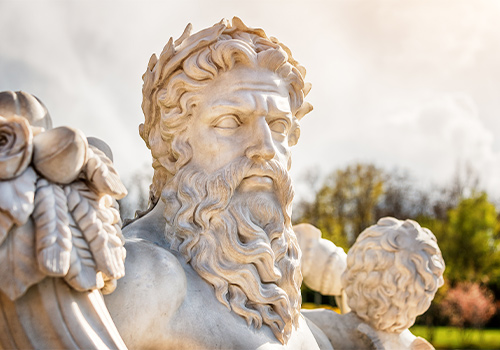 When you hear the term “creation story,” you likely think of the biblical account of God creating the earth, sea, sky, sun, moon, animals, and finally Adam and Eve all in six days. Then on the seventh day God rested, giving rise to the Sabbath — Sunday for Christians, Saturday for Jews, and Friday for Muslims — the day of the week on which adherents of these three religions honor God.
When you hear the term “creation story,” you likely think of the biblical account of God creating the earth, sea, sky, sun, moon, animals, and finally Adam and Eve all in six days. Then on the seventh day God rested, giving rise to the Sabbath — Sunday for Christians, Saturday for Jews, and Friday for Muslims — the day of the week on which adherents of these three religions honor God.
But the Abrahamic God is far from the only deity with a creation story. Virtually every major religion since time immemorial has its own creation story. Most of them are polytheistic, with a variety of gods and goddesses rather than only one all-powerful, omniscient god. Here are four of these creation stories and the cultures that produced them.
Ancient Greeks
As recounted in Hesiod’s Theogony, Gaia, the mother earth goddess, arose from the primordial chaos and created Uranus (the sky) so she could cover herself. These two deities then produced a number of first-tier gods, including the Cyclopes (one-eyed monsters), the Hecatonchires (monsters with 100 hands and 50 heads), and 12 gods known as the Titans. Since most of these “children” were indeed monsters, Uranus imprisoned them in the bowels of the earth, known as Tartarus. In retaliation, Gaia made a huge sickle and gave it to Cronus, her youngest son. The next time Uranus came calling on Gaia, Cronus castrated Uranus. When these body parts hit the ground, they produced numerous additional monsters, known as the Giants and the Furies. Where the body parts hit the oceans, they produced Aphrodite, the goddess of love. Cronus himself subsequently fathered the second-tier gods, including the Olympians and Zeus, the god of thunder and lightning. Eventually, Zeus overthrew his father Cronus and became king of the gods.
Babylonians
Babylonia was the largest city in the ancient (ca. 2,300 B.C.) kingdom of Mesopotamia located along the Euphrates River in present-day Iraq. The Babylonian creation story, known as the Enuma Elish, started with the fresh-water god Apsu and the salt-water goddess Tiamat. These two produced several generations of gods, including Ea. Apsu was not enamored with any of his children and attempted to kill them. Ea, however, interceded, killing Apsu instead. Ea and the goddess Damkina subsequently spawned Marduk, a four-eyed, four-eared giant, to be their protector against Tiamat, who had sworn vengeance against Ea for killing her husband Apsu. Ultimately Marduk killed Tiamat, splitting her body in half to create the earth and sky. Then he created human beings to do the bidding of the gods.
Middle Kingdom Chinese
For the ancient Chinese of the Middle Kingdom (ca. 1,000 B.C.), the opposing forces of yin and yang emerged out of the timeless void as a cosmic egg that created the earth (yin) and sky (yang), and ultimately Pan-gu, the first god. When Pan-gu died some 18,000 years later, his body parts created the universe, including the animals, the weather, and all of the celestial bodies. Additional gods and goddesses sprang up, including Nuwa, a lonely goddess who created human beings from the mud of the Yellow River. These humans became nobles. Nuwa also created the common class of humans by means of throwing muddy droplets out over the earth.
Aztecs
The Aztecs, the 12th Century civilization of present-day Mexico, also had a creation story. The Aztecs’ story begins with Coatlicue, their version of Gaia; i.e., mother earth. An obsidian knife impregnated her, producing Coyolxauhqui, the moon goddess, and 400 sons who became the stars in the sky. Coatlicue subsequently became pregnant again, this time via a ball of feathers that fell from the sky. Coyolxauhqui and her brothers rose up against their mother for this pregnancy, but before they could kill her, Huitzilopochtli, the god of war and the sun, sprang from her womb fully grown and armored. He killed Coyolxauhqui, aided by his fire serpent, by cutting off her head and flinging it into the sky, where it became the moon.
Nearly every civilization in history has an origin myth. The ancient Persians, Egyptians, Romans, Hindus, Japanese, Norsemen, Native Americans - the list goes on. All have fascinating creation stories and all are worth researching.
It is obvious that since the beginning of recorded history, and undoubtedly before then, human beings have sought to understand their place in the cosmos, the universe itself, and how we all got here.
Curiosity is embedded in the human psyche. It’s only natural that we seek answers to life’s big questions. And as evidenced by the origin stories of ancient cultures, this curiosity is most certainly not a modern phenomenon. And just as in the past, as time ebbs on, it is likely more creation stories will be created - and others will pass into myth.
Add Your Comment